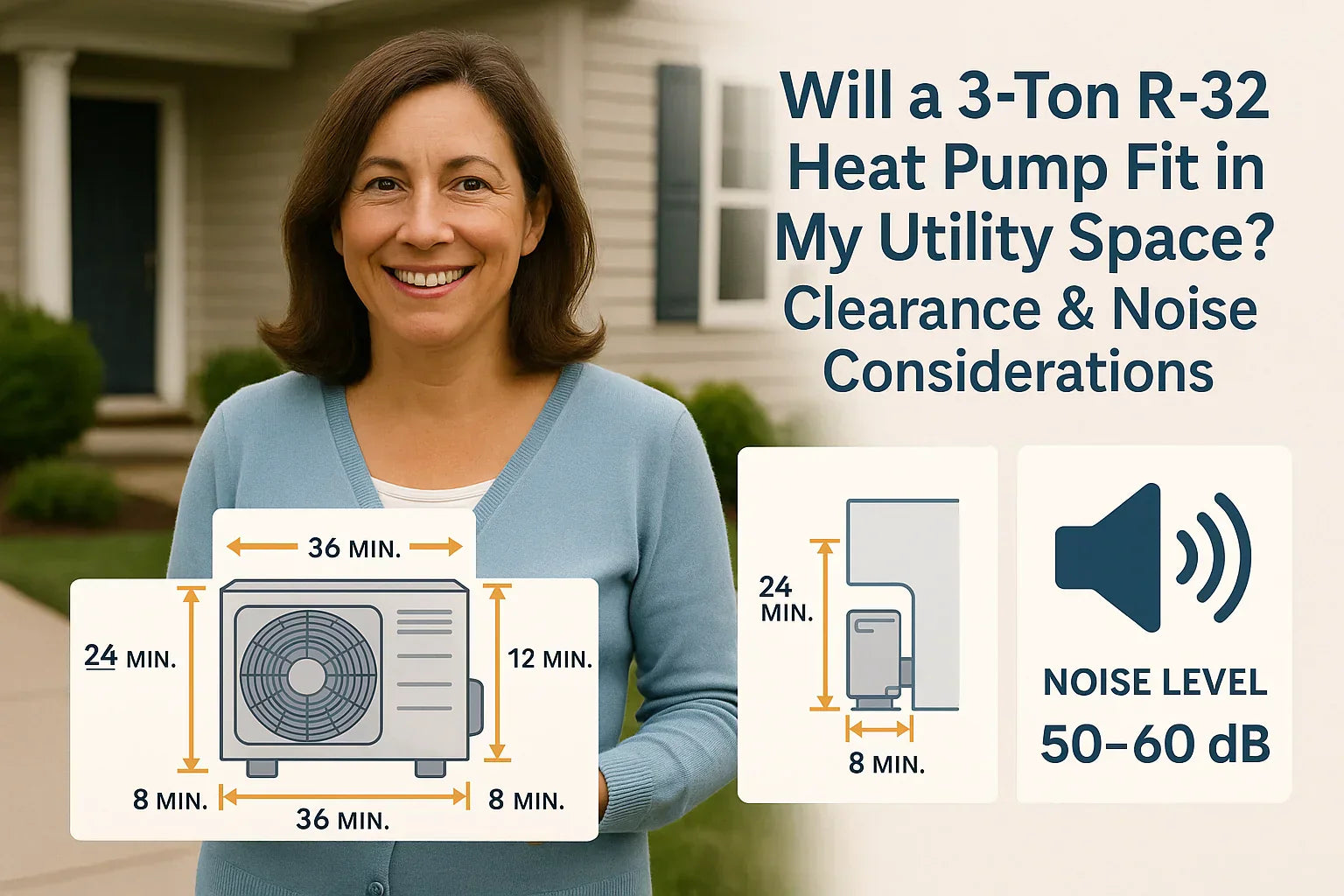💬 Introduction: When Size & Sound Matter
When I ordered my 3-ton R-32 heat pump, I thought I was ahead of the game—I measured my utility room twice and checked the spec sheet once. Rookie mistake.
Turns out, fitting the unit physically isn’t enough. You also need to consider clearance for airflow, safe handling of R-32 refrigerant, and noise levels—or you risk reduced efficiency, loud operation, and possible code violations.
This guide walks you through exactly how to figure out if your R-32 heat pump will fit and function in your space—whether you’re putting it in a utility closet, basement, garage, or on an outdoor pad.
📏 Physical Dimensions of a 3-Ton R-32 Heat Pump
Indoor Air Handler Size
-
Height: 40–60 inches
-
Width: 18–24 inches
-
Depth: 20–24 inches
-
Weight: 90–150 lbs
Outdoor Condenser Size
-
Height: 30–40 inches
-
Width: 35–40 inches
-
Depth: 12–18 inches
-
Weight: 150–250 lbs
Pro Tip: Check your manufacturer’s installation manual for exact measurements (Daikin Installation Manual PDF). R-32 systems may have slightly different coil and casing designs than R-410A units, so don’t assume they’re interchangeable.
📐 Minimum Clearance Requirements
Manufacturers list clearance distances to ensure airflow and service access:
| Location | Minimum Clearance | Why It Matters |
|---|---|---|
| Front (Air Intake) | 24–36 inches | Allows adequate airflow for heat exchange |
| Back (Wall Side) | 6–12 inches | Prevents airflow blockage and overheating |
| Sides | 12–24 inches | Enables service access and lateral airflow |
| Top | 48 inches | Hot air exhaust needs unimpeded rise |
Rule of Thumb: More space is better than minimum—tight fits often increase fan noise and reduce efficiency.
🔊 Noise Level Expectations
Noise is one of the most overlooked aspects of HVAC placement.
Outdoor Unit Noise
-
Typical inverter-driven R-32 models: 50–60 dB (similar to a normal conversation).
-
Single-stage models: 60–70 dB (vacuum cleaner range).
Indoor Air Handler Noise
-
Low fan: 25–35 dB (quiet library).
-
High fan: 40–50 dB (office background noise).
Noise Reduction Strategies
-
Install vibration isolation pads under the condenser.
-
Place outdoor units away from bedroom windows.
-
Use fencing or shrubbery to deflect noise (while maintaining airflow clearance).
For noise comparisons, the CDC Environmental Noise Guidelines are a great reference.
🏠 Indoor vs. Outdoor Placement
Indoor Placement (Utility Room, Basement, Garage)
✅ Protected from weather
✅ Easier service access in bad weather
⚠ Must provide ventilation for R-32 refrigerant safety (AHRI A2L Safety Guidelines)
⚠ May require condensate management in cooling mode
Outdoor Placement (Pad, Balcony, Side Yard)
✅ No indoor ventilation concerns
✅ Less noise transfer indoors
⚠ Needs weather-resistant electrical and drain setup
⚠ Snow and debris protection required in colder climates (Energy.gov Heat Pump Tips)
⚠️ R-32 Safety & Space Requirements
Because R-32 is an A2L mildly flammable refrigerant, placement in confined spaces requires:
-
Adequate ventilation to prevent buildup in case of a leak.
-
No open flames, sparks, or ignition sources within the clearance zone.
-
Compliance with ASHRAE Standard 15 for refrigerant machinery rooms (ASHRAE Refrigerant Safety Standards).
If your utility space is small and sealed, you may need mechanical ventilation or to choose an outdoor placement.
🛠️ Samantha’s Space Planning Tips
From my own installation experience:
-
Mark the Footprint – Use painter’s tape on the floor to visualize the unit and clearance zones.
-
Simulate Service Access – Make sure you can comfortably get tools behind and beside the unit.
-
Plan for Airflow Paths – Hot discharge air shouldn’t recirculate into the intake.
-
Think About Future Noise – Even quiet units get louder over time as fans and bearings wear.
-
Check Local Codes – Some areas have specific setbacks for exterior units and ventilation rules for R-32 indoors.
💰 Potential Extra Costs if You Don’t Plan Ahead
-
Repositioning the unit: $200–$500 labor.
-
Adding ventilation: $500–$1,500 for mechanical vent installation.
-
Noise barriers: $200–$600 for fencing or acoustic panels.
💬 Closing Thoughts
A 3-ton R-32 heat pump will fit in most utility spaces—but the question isn’t just “will it fit?” It’s “will it breathe, run quietly, and stay safe?”
Plan for clearance, ventilation, and noise control up front, and you’ll enjoy years of efficient, quiet comfort without costly modifications later.
In the next topic we will read about: Do 3-Ton R-32 Heat Pumps Qualify for Energy Rebates or Tax Credits in 2025?







